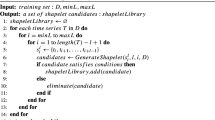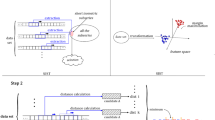Abstract
With the rapid development of pervasive devices, a great deal of time series are generated by various sensors, and many time series classification (TSC) algorithms have been proposed to deal with these data. Among them, shapelet-based algorithms have attracted great attention due to its high accuracy and strong interpretability. However, time complexity of shapelet-based algorithms is high. In this paper, we propose an improved Fast Shapelet Selection algorithm based on Clustering (FSSoC), which greatly reduces the time of shapelet selection. Firstly, time series are clustered into several groups with improved k-means, and then some time series are sampled from each cluster with a strategy based on Euclidean Distance sorting. Secondly, Important Data Points (IDPs) of the sampled time series are identified and only the subsequences between two nonadjacent IDPs are added to shapelet candidates. Therefore, the number of shapelet candidates is greatly reduced, which leads to a obviously reduction in time consumption. Thirdly, FSSoC is applied to shapelet transformation algorithm to test classification accuracy and running time, the experiments demonstrate that FSSoC is obviously faster than existing shapelet selection algorithms while keeping a high accuracy. At last, a case study on EEG time series is presented, which verifies the feasibility of FSSoC application to automatically discover representative EEG features.







Similar content being viewed by others
References
Yacchirema D, De Puga J, Palau C, et al. (2019) Fall detection system for elderly people using IoT and ensemble machine learning algorithm. Pers Ubiquit Comput 23(5):801–817
Joo W, Choi K, Kim Y, et al. (2019) Deep learning model for unstructured knowledge classification using structural features. Pers Ubiquit Comput 24(3):1–12
Ye L, Keogh E (2009) Time series shapelets: a new primitive for data mining. Knowledge discovery and data mining:947–956
Yu XM, Wang H, Zheng XW, et al. (2016) Effective algorithms for vertical mining probabilistic frequent patterns in uncertain mobile environments. Int J AD HOC Ubiq Comput 23(3-4):137–151
Hills J, Lines J, Baranauskas E, et al. (2014) Classification of time series by shapelet transformation. Data Min Knowl Disc 28(4):851–881
Mueen A, Keogh E, Young NE (2011) Logical-Shapelets: An expressive primitive for time series classification. In: Proceedings of the 17th ACM SIGKDD international conference on knowledge discovery and data mining, pp 1154–1162
Bagnall AJ, Bostrom A, Large J, et al. (2016) The great time series classification bake off: an experimental evaluation of recently proposed algorithms. Extended Version, arXiv: Learning, arXiv:1602.01711
Ji C, Zhao C, Liu S, et al. (2018) A fast shapelet selection algorithm for time series classification. Comput Netw 148:231–240
Jeong Y, Jeong MK, Omitaomu OA, et al. (2011) Weighted dynamic time warping for time series classification. Pattern Recogn 44(9):2231–2240
Stefan A, Athitsos V, Das G, et al. (2013) The move-split-merge metric for time series. IEEE Trans Knowl Data Eng 25(6):1425–1438
Batista GE, Keogh E, Tataw OM, et al. (2014) CID: an efficient complexity-invariant distance for time series. Data Min Knowl Disc 28(3):634–669
Gorecki T, Luczak M (2013) Using derivatives in time series classification. Data Min Knowl Disc 26(2):310–331
Senin P, Malinchik S (2013) SAX-VSM: interpretable time series classification using SAX and vector space model. International conference on data mining:1175–1180
Kate RJ (2016) Using dynamic time warping distances as features for improved time series classification. Data Min Knowl Disc 30(2):283–312
Schafer P (2015) The BOSS is concerned with time series classification in the presence of noise. Data Min Knowl Disc 29(6):1505–1530
Baydogan MG, Runger GC (2016) Time series representation and similarity based on local autopatterns. Data Min Knowl Disc 30(2):476–509
Baydogan MG, Runger GC, Tuv E, et al. (2013) A bag-of-features framework to classify time series. IEEE Trans Pattern Anal Mach Intell 35(11):2796–2802
Lines J, Bagnall AJ (2015) Time series classification with ensembles of elastic distance measures. Data Min Knowl Disc 29(3):565–592
Ye L, Keogh E (2011) Time series shapelets: a novel technique that allows accurate, interpretable and fast classification. Data Min Knowl Disc 22(1):149–182
Grabocka J, Wistuba M, Schmidtthieme L, et al. (2016) Fast classification of univariate and multivariate time series through shapelet discovery. Knowl Inf Syst 49(2):429–454
Renard X, Rifqi M, Erray W, et al. (2015) Random-shapelet: an algorithm for fast shapelet discovery. IEEE international conference on data science and advanced analytics: 1–10
Gordon D, Hendler D, Rokach L, et al. (2015) Fast and space-efficient shapelets-based time-series classification. Intell Data Anal 19(5):953–981
Karlsson I, Papapetrou P, Bostrom H, et al. (2016) Generalized random shapelet forests. European Conference on Machine Learning 30(5):1053–1085
Zhang Z, Zhang H, Wen Y, et al. (2016) Accelerating time series shapelets discovery with key points. Asia-Pacific web conference: 330–342
Ji C, Zhao C, Pan L, et al. (2019) A just-in-time shapelet selection service for online time series classification. Comput Netw 157:89–98
Xing SN, Liu FA, Wang QQ, et al. (2019) A hierarchical attention model for rating prediction by leveraging user and product reviews. Neurocomputing 322:417–427
Rakthanmanon T, Keogh E (2013) Fast shapelets: a scalable algorithm for discovering time series shapelets. SIAM international conference on data mining, pp 668–676
Grabocka J, Schilling N, Wistuba M, et al. (2014) Learning time-series shapelets, knowledge discovery and data mining: 392–401
Lines J, Davis LM, Hills J, et al. (2012) A shapelet transform for time series classification, knowledge discovery and data mining, pp 289–297
Liu R, Wang H, Yu XM (2018) Shared-nearest-neighbor-based clustering by fast search and find of density peaks. Inform Sci 450:200–226
Bagnall A, Lines J, Vickers W, Keogh E (2016) The UEA & UCR time series classification repository, www.timeseriesclassification.com
Arul M, Kareem A (2019) Shapelets for earthquake detection, arXiv: Learning, arXiv:1911.09086
Aldhanhani A, Damiani E, Mizouni R, et al. (2019) Framework for traffic event detection using Shapelet transform. Eng Appl Artif Intel 82:226–235
Zorko A, Fruhwirth M, Goswami N, et al. (2020) Heart rhythm analyzed via shapelets distinguishes sleep from awake. Front Physiol 10(1):1–16
Hong L, Yang X, Zheng W, et al. (2019) Emotional regulation goals of young adults with depression inclination: an event-related potential study. Acta Psychologica Sinica 51(6):637–647
Funding
We are grateful for the support of the Natural Science Foundation of Shandong Province, China (No. ZR2019MF071), the National Natural Science Foundation of China (No. 61373149, 61672329).
Author information
Authors and Affiliations
Corresponding authors
Additional information
Publisher’s note
Springer Nature remains neutral with regard to jurisdictional claims in published maps and institutional affiliations.
Rights and permissions
About this article
Cite this article
Zou, X., Zheng, X., Ji, C. et al. An improved fast shapelet selection algorithm and its application to pervasive EEG. Pers Ubiquit Comput 26, 941–953 (2022). https://doi.org/10.1007/s00779-020-01501-4
Received:
Accepted:
Published:
Issue Date:
DOI: https://doi.org/10.1007/s00779-020-01501-4




